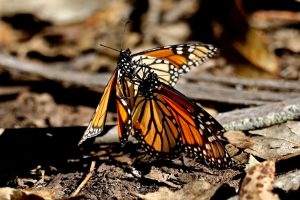A flutter of magical hope on the Central Coast, as monarch butterflies return
The data made clear what many have been noting since October: The monarchs are back, even if it’s far from the millions that arrived as recently as the ’80s.
Source of this article: The Los Angeles Times, February 2, 2022
OS OSOS, Calif. — There was the distinctive noise of something falling.
Plop.
Plop. Plop.
It was the sound of pairs of monarch butterflies hitting the ground.
Mating season, which sometimes involves the male monarch hurtling the female from canopy to earth, had come early. In a small eucalyptus grove at the end of a housing tract, it was raining butterflies.
One pair landed next to a black Labrador stretched out in dappled sun. The dog wiggled to her feet.
“Careful, Shilo! Don’t step on the butterflies,” called her owner, Nate Everitt, who lives nearby and volunteers in the Coastal Access Monarch Butterfly Preserve in Los Osos.
Kingston Leong, an entomologist who watches over this and other little-known Central Coast monarch havens — and the first to document hurtling-from-the-treetops mating behavior — kept his eyes on the butterflies missed by Shilo’s paws.
“They’re going to spiral,” he said.
They did. Two interlocked butterflies looped upward, a tumbling bright orange against bright-blue sky, landing on the top of a Monterey pine.
Leong pointed out that the sunlight shining through their patterned, orange-gold wings made them glow like stained glass in a cathedral.
In any year, the overwintering of monarch butterflies on the California coast is a phenomenon. But this one comes after two years when the butterflies had all but disappeared.
The Xerces Society for Invertebrate Conservation announced in late January that community scientists had reported 247,000 overwintering butterflies in the 2021 Western Monarch Thanksgiving Count. There were fewer than 2,000 the year before. The data made clear what many have been noting since October: The monarchs are back, even if it’s far from the millions that arrived as recently as the ’80s.
Leong thinks this is an important development — for people as well as for butterflies. He has observed that the sight of overwintering monarchs tends to give people a sense of optimism.
“I think we need optimism to survive,” he said. “We need hope, don’t you think?”
As a professor at Cal Poly San Luis Obispo, Leong once specialized in insect pests. But after his department head suggested he study butterflies, he was quickly converted.
“Who doesn’t like butterflies?” he asked.
In the grove, the 81-year-old was easily pegged as an expert, given away by his prowess with a 15-foot butterfly net. Visitors — including two cyclists from Oregon, neighbors who walked here each day and a Los Angeles man who had never before seen so many butterflies — peppered him with questions.
He asked each to first tell him what they already knew.
The give-and-take sketched the basics of the monarch migration.
Monarchs east of the Rockies migrate south, to oyamel fir forests in Mexico’s Sierra Madre. Monarchs west of the Rockies overwinter on the Central Coast of California, often on nonnative eucalyptus trees that were planted in great numbers for use as railroad ties but proved unsuitable.
The two butterfly groups were once thought to be different species, but it has since been proved that the Mexican and Californian butterflies are the same.
The butterflies migrate upward of 3,000 miles on wings that weigh the slightest fraction of an ounce.
The California population usually arrives in October and stays into February, or sometimes even March. Then, as it warms, the butterflies leave the roost and lay eggs on milkweed plants. The eggs become milkweed-eating caterpillars that morph into butterflies that flit among flowers, living about a month while moving north.
It is believed to take four or five leapfrogging generations for the monarchs to return as far north as the Canadian border. Then, once again, a generation will be born with the longer life span, greater strength and instinct to migrate to a place that those particular butterflies have never been before.
Probably the most well-known California overwintering site is a grove at Pismo Beach, a town that’s all in on butterfly tourism, from T-shirts to lollipops to waiting docents.
But monarchs have taken winter residence in at least 300 spots along the California coast, and that’s where Leong comes in. He is the go-to source for creating and managing the region’s monarch groves.

Kingston Leong, 81, captures monarchs to study at the Coastal Access Monarch Butterfly Preserve. A butterfly expert, he wants to make sure “the show continues after I’m gone.”
The Los Osos preserve was carved from a housing development. Leong convinced the developer to donate public open space for a butterfly sanctuary and asked for $50,000 to modify and manage the grove far into the future.
The pine decorated with monarchs was one that, under his direction, was planted to block the wind. He had asked county crews to take out other trees to let in more sun.
Now, at this moment and at this place, it was monarch perfection. The right temperature and humidity. The right play of sun and shadow. A breeze that was suitably gentle. The monarchs perched, floated and spiraled.
Clara and Teddy Crutchfield, 2-year-old twins, sat on a bench watching. Leong caught two butterflies in his net and had the children cup their hands, each closing their fingers over a butterfly, then slowly open their hands to watch it fly.
At this stage of his life, Leong said, his main interest is passing on his knowledge. One of his favorite protégés is Josh Heptig, a golf course manager.
For decades the monarchs have roosted on the Morro Bay Golf Course, owned by San Luis Obispo Parks and Recreation. Heptig, alarmed by dwindling numbers, is doing what he can to keep the golf course to the monarchs’ liking.
In consultation with Leong, he planted a screen of trees to block the wind.
One homeowner protested. He told Heptig he didn’t care about any butterflies — he cared about his ocean view and house value. That man has since moved, and Heptig went door to door explaining the goal and winning the support of neighbors.
On a walk with Leong past the driving range to the monarch grove, Heptig pointed out his plans for the future. He envisions a covered walkway so people can visit the monarchs without getting beaned by golf balls.
“He’s so quick and imaginative,” Leong said. “I like how Josh thinks. He’s the hope.”
They had reached a grove of trees that children in the community had planted, on Heptig’s invitation.
“No,” said Heptig. “Here’s the hope.”
Leong’s hypothesis is that California’s wildfires over the past two years contributed to the dramatic drop in monarchs, based on a small study he conducted that showed the insects to be sensitive to smoke.
This year’s comeback is far greater than could have been produced by the previous year’s tiny population. Leong thinks some of the butterflies that overwintered in Mexico may have come west.
The more long-term drop in numbers is believed to be tied to loss of habitat — fewer fields of milkweed, the butterflies’ host plant along their migration route, and fewer overwintering sites.
Fiscalini Ranch Preserve, a community-saved open space that stretches along a mile of coast in Cambria, is one of the more recently discovered monarch sites. Five years ago, a roost was found in native pines.
On a recent day, the ranch’s executive director, Kitty Connolly, laughed when a monarch landed in front of the sign marking the grove: “Look. Wonder. Marvel. Please Be Kind to Monarchs.”
The return of the butterflies at Fiscalini was particularly surprising given that a severe storm knocked down trees this winter.
“Their return means so much,” Connolly said. “People are desperate for any bit of good news.”
A man entered the preserve. Connolly said good morning and asked if he had noticed the butterflies.
“No,” he said, looking panicked. “I just got news that my mother died. I didn’t notice anything.”
She wished him a good walk. As he went on his way, Connolly said that grieving people often seek out this space.
Later, the man sat on a bench on a hill with a vast, spreading view of the Pacific Ocean.
He spoke of his mother, who married at 19, raised seven children in Chicago, loved books and started a library. He wished he could have visited her more during the pandemic.
A monarch looped past, a dazzling, orange splash against the backdrop of blue sea.
“I don’t know why,” he said. “But that butterfly matters so much to me right now.”







0 Comments